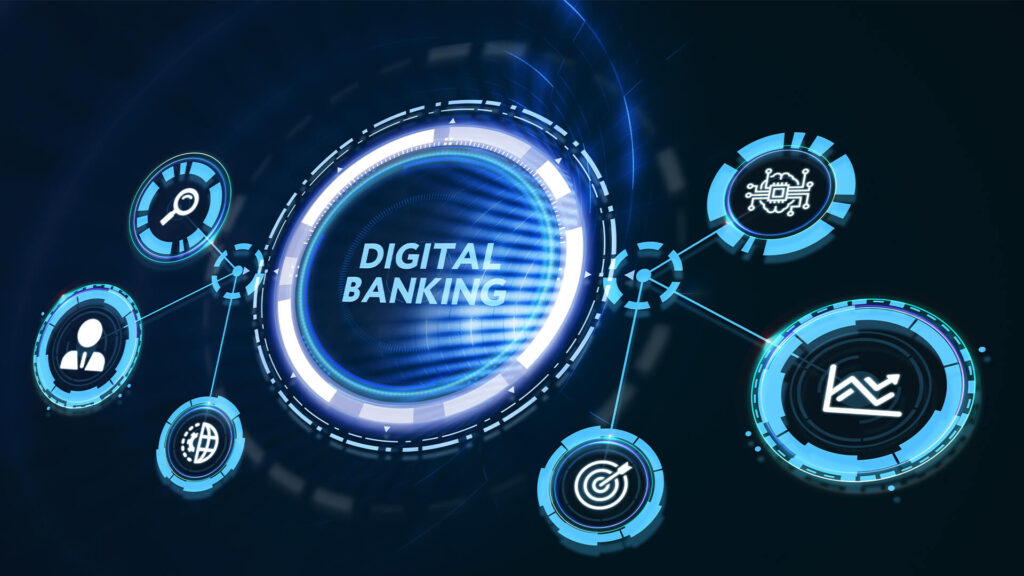Digital transformation, or simply using digital technology in every aspect of company, fundamentally altering how it operates and providing benefits to its customers, is changing the banking sector. With the help of extensive digital transformation strategies banks have been able to move away from their conventional practices.
Traditionally, banks were characterized through physical banks, face-toface interactions and transactions that were conducted on paper. But, the advent of digital technology has transformed the landscape of banking. Banking is now more frequently on a mobile device than it does in the physical space. With the ever-growing demands for personalization, convenience, and availability 24/7 and accessibility, the need for bank transformation has never been more urgent.
The the digital transformation of banking is an intriguing tale of adaptability, creativity and customer-centricity. This transformation has not just offered customers better methods of conducting financial transactions, but has also pushed banks to increase their standards of service continuously.
The Evolution of Digital Transformation in Banking
Historical Perspective Traditional Banking in contrast to. Modern Banking
Traditional banking was mostly manual, and was characterized by physical branches, face-to-face interactions, as well as paper-based transactions. Customers had to go to the bank for nearly every financial need such as paying money in, requesting loans, or simply looking up their balance.
Physical interactions have been cut substantially, and have been replaced by digital platforms that provide speedier and faster, and more effective services. The focus is now on delivering a seamless user experience, personalised services and new financial products.
Stages of Digital Transformation in Banking: Early Adoption, Growth, and Maturity
Digital transformation in banking could be classified into three major phases: early adoption, development, and maturation.
- The early Adoption: This phase was characterized by banks that took its first tentative steps in the electronic age and primarily by introducing online banking. Automated Teller Machines were also introduced in this period, providing customers the option of self-service for simple banking.
- growth: In the stage of growth the banks started to broaden their offerings via digital channels. Mobile banking apps became a common feature with features such as the remote deposit of checks, instant account update as well as person-to-person payment were added. Banks also began to utilize data analytics to gather customer information and provide personalized services.
- Maturity: The stage of maturity that we are in now, is when banks are adopting advanced technologies such as artificial intelligence blockchain, machine learning, and robotic process automatization in their business processes. These new technologies have further simplified processes, improved security, and enabled banks to provide more ingenious solutions and products.
Key Drivers of Digital Transformation in Banking
Changing Customer Expectations and Behavior
One of the main reasons for the digital transformation of banking is the shifting expectations and behaviour of customers.
Modern customers want convenience as well as speed and personalization. They require all-hours access to financial services at any time, quick answers to their queries and personalized financial products to meet the needs of each individual.
The increasing number of the digitally native, who grew up with internet access as well as smartphones has intensified the requirements. The requirement to meet or exceed these expectations has driven banks to invent and improve their operations on a constant basis.
Regulatory and Competitive Pressures
The regulatory pressures have also played an important role in the acceleration of the digital transformation.
The world’s regulatory and government agencies are encouraging digitalization to improve transparency, improve security, and encourage financial inclusion. In some instances they’re also introducing open banking regulations which oblige banks to share their data about customers with third-party service providers which encourages innovation and competition within the banking industry.
Technological Advancements and Innovations
In the end, technological advances can be a major driver for digital transformation.
From mobile and internet technology to AI machine learning blockchain, cloud computing and RPA Every technological advance has opened new avenues for banking digitalization.
As these technologies continue to advance and develop, they are expected to continue to transform the banking industry, allowing banks to improve their offerings and streamline their operations, improve security, and provide greater value to their customers.
Areas of Digital Transformation in Banking

Mobile and Online Banking
Online and mobile banking have emerged as the main methods for customers to get access to financial services. From checking balances on their checking accounts, the transfer of funds and paying bills to applying for loans, customers are able to perform a variety of transactions whenever they want. Banks are also beginning using data analytics to give individualized financial recommendations and advice and enhance the banking experience online.
Digital Payments and Wallets
Digital wallets and payments have changed our way of doing business. They are a faster more secure, safer, and more convenient method to pay as compared conventional methods. Banks have designed electronic wallets of their own, joined with third-party service providers and integrated to mobile payments platforms in order to satisfy the growing demand for digital transactions.
AI and Machine Learning in Financial Decision-Making
AI as well as machine-learning are now being employed to automate and improve the decision-making process in the banking industry. They are utilized to score credit, fraud detection as well as risk management and the provision of investment advice services for instance. Through analyzing huge quantities of data and taking advantage of trends from the past These technologies assist banks to take more precise and informed decisions.
Blockchain and Cryptocurrencies
Blockchain technology has the potential to transform a variety of areas of the banking industry, from payment and remittances, to identification verification as well as compliance. While it’s still in its early stage there are some banks that have begun testing blockchain-based trades between banks, smart contracts or tokenized asset. However the rise of cryptocurrency has triggered the development of crypto-banking solutions, which provide traditional banking services for digital assets.
Robotic Process Automation for Operational Efficiency
RPA is being utilized for automating repetitive and rule-based processes in banking, including the entry of data, processing transactions compliance reporting, as well as customer service requests. Through automation of these tasks, banks can increase their efficiency and effectiveness, cut down on mistakes, and free employees to concentrate on more strategic, valuable tasks.
Impact of Digital Transformation on Stakeholders
Benefits to Customers: Convenience, Personalization, and Enhanced Services
Customers are the main customers of the digital revolution in banking. The move to mobile and online banking have made bank more accessible and allows customers to complete financial transactions from any location, anytime.
Benefits to Banks: Efficiency, Cost Savings, and New Business Models
The digital revolution for banking can bring efficiency in operations, cost reductions as well as the possibility to take advantage of innovative business strategies. Automating routine tasks can reduce operating costs and speed up the delivery of services.
The application technology such as AI as well as machine-learning could help improve decision-making and lead to more efficient risk management as well as better financial results.
Impact on Employees: Upskilling, Automation of Repetitive Tasks, and Job Transformation
Digital transformation is a significant issue for the employees working in the banking sector. Automating repetitive tasks may allow employees to concentrate upon more important, valuable tasks, it requires upgrading and reskilling in order to adapt to the changing digital landscape. Certain jobs may be obsolete, but new ones are emerging in areas such as analytics, AI as well as digital experience for customers.
Impact on Regulators and Policymakers: New Challenges and Opportunities
The policymakers and regulators have different challenges as well as opportunities due to the transformation of banking to digital. On the one side, they must make sure that the digital revolution does not affect the stability of financial markets, consumer protection and data privacy.
On the contrary, digitalization can provide opportunities to boost financial inclusion, increase compliance with regulations through RegTech and encourage innovation and competition within the banking industry.
Case Studies of Successful Digital Transformation in Banking
Fintech Startups Disrupting the Industry
Fintech startups, thanks to their ingenuous business models and their technology-first approach have been in the frontline of digital revolution in banking. For example, companies such as Revolut and Wise have revolutionized traditional banking with their digital-first strategy, providing various services, including international money transfers and trading in cryptocurrency, all through an app for mobile devices.
Traditional Banks That Have Successfully Transformed Digitally
The traditional banks too are adopting digital transformation. For instance, take DBS Bank, for instance that has been hailed as the World’s Top Digital Bank’ by Euromoney.
DBS has greatly transformed its operations into digital, making use of data analytics to deliver customized services, using cloud computing to increase efficiency and operational efficiency, as well as the introduction of a digital-only banking model for India in addition to Indonesia.
Cooperative and Rural Banks’ Adaptation to Digital Transformation
Digital transformation isn’t only confined to large banks and fintechs. smaller institutions, like rural and cooperative banks are also adopting digitalization.
A good illustration of this is An example is the Cooperative Bank in the UK which has implemented a successful digital strategy, providing mobile and online banking and utilizing technology to streamline its processes.
Challenges and Risks in Digital Transformation
Cybersecurity and Data Privacy Concerns
As banking is becoming increasingly digital security and privacy concerns, cybersecurity have become major concerns. Banks should invest in strong security measures to guard from cyber attacks and ensure that their customers are treated with care in order to keep confidence.
Regulatory Compliance in a Rapidly Evolving Digital Landscape
The speedy nature of digital technology presents challenges to the regulatory compliance. Regulators often struggle to stay up-to-date with the rapid pace of technological innovations and banks have to be aware and proactive in following the ever-changing regulatory landscape.
Technological Complexities and Implementation Challenges
Implementing new technology comes with many issues. They can vary from technical issues including integrating new technology with existing systems, and to organizational challenges like managing change and training employees.
The Digital Divide and Financial Inclusion
While digital transformation can bring many advantages, it could also be expanding the digital gap. Many people don’t have access the internet or to digital devices, so it’s vital for banks to ensure their digital strategies do not make them a victim.
What is the Future of Banking with Digital Transformation
Predictions Based on Current Trends
In the future in we can expect the transformation of banking to be digital and to accelerate. It is likely that we will see more acceptance of AI and machine learning to aid in making decisions, a greater use of blockchain to secure transactions and more banks converting into digital only models.
Emerging Technologies and Their Potential Impact
New technologies, like quantum computing, that rely on the fundamentals of quantum physics have the potential to change the way banks and financial services. The technology could increase decision-making capability, improve efficiency, and provide top-quality solutions to the most complex financial issues.
Role of Banks in the Future Digital Economy
In the upcoming digital world banks are likely to play a major role. They will not just offer financial services, but also serve in the role of facilitators for digital products and services, working with tech companies and fintech firms to provide a variety of digital services and products. It is expected that banks constantly innovate and change to stay relevant in an changing digital landscape.
Summary
Digital transformation has already affected the banking industry by making financial services accessible and efficient. It also makes it more user-friendly. This has led to a change in the traditional banking model that are focusing on adaptability and innovation being a key factor for the success of. It is important to keep in mind that this change isn’t without its difficulties. From cybersecurity concerns and compliance to the technical complexities and the threat of an expanding digital divide. There are many challenges banks face.

